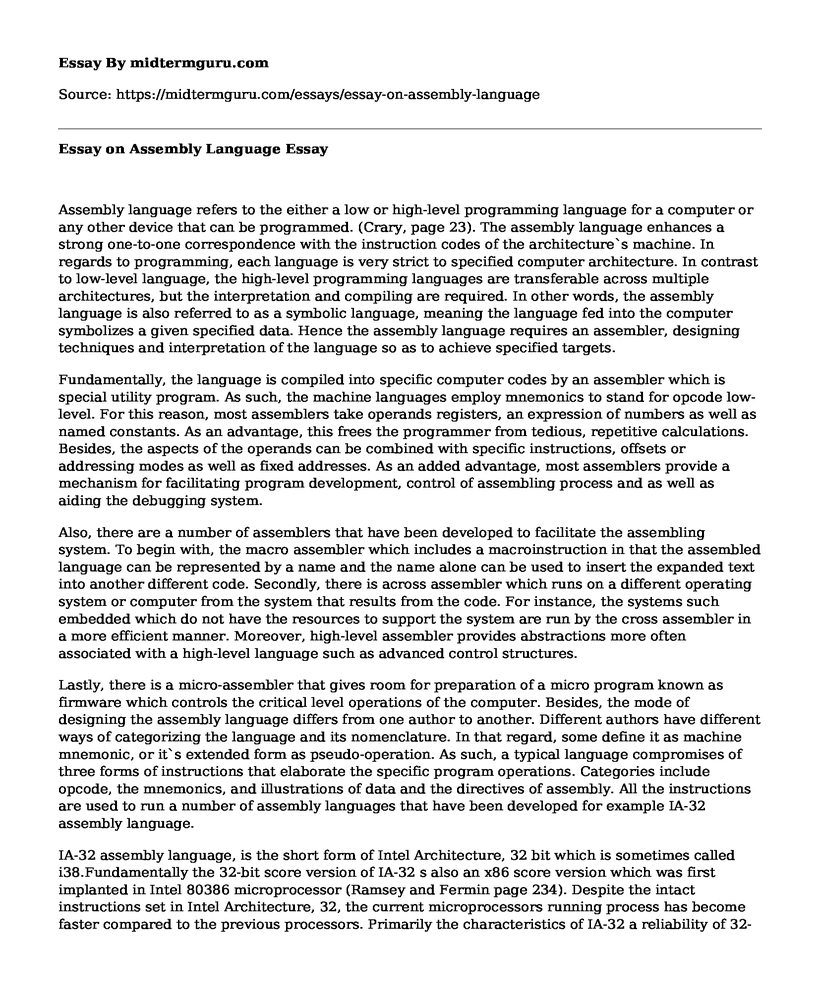Assembly language refers to the either a low or high-level programming language for a computer or any other device that can be programmed. (Crary, page 23). The assembly language enhances a strong one-to-one correspondence with the instruction codes of the architecture`s machine. In regards to programming, each language is very strict to specified computer architecture. In contrast to low-level language, the high-level programming languages are transferable across multiple architectures, but the interpretation and compiling are required. In other words, the assembly language is also referred to as a symbolic language, meaning the language fed into the computer symbolizes a given specified data. Hence the assembly language requires an assembler, designing techniques and interpretation of the language so as to achieve specified targets.
Fundamentally, the language is compiled into specific computer codes by an assembler which is special utility program. As such, the machine languages employ mnemonics to stand for opcode low-level. For this reason, most assemblers take operands registers, an expression of numbers as well as named constants. As an advantage, this frees the programmer from tedious, repetitive calculations. Besides, the aspects of the operands can be combined with specific instructions, offsets or addressing modes as well as fixed addresses. As an added advantage, most assemblers provide a mechanism for facilitating program development, control of assembling process and as well as aiding the debugging system.
Also, there are a number of assemblers that have been developed to facilitate the assembling system. To begin with, the macro assembler which includes a macroinstruction in that the assembled language can be represented by a name and the name alone can be used to insert the expanded text into another different code. Secondly, there is across assembler which runs on a different operating system or computer from the system that results from the code. For instance, the systems such embedded which do not have the resources to support the system are run by the cross assembler in a more efficient manner. Moreover, high-level assembler provides abstractions more often associated with a high-level language such as advanced control structures.
Lastly, there is a micro-assembler that gives room for preparation of a micro program known as firmware which controls the critical level operations of the computer. Besides, the mode of designing the assembly language differs from one author to another. Different authors have different ways of categorizing the language and its nomenclature. In that regard, some define it as machine mnemonic, or it`s extended form as pseudo-operation. As such, a typical language compromises of three forms of instructions that elaborate the specific program operations. Categories include opcode, the mnemonics, and illustrations of data and the directives of assembly. All the instructions are used to run a number of assembly languages that have been developed for example IA-32 assembly language.
IA-32 assembly language, is the short form of Intel Architecture, 32 bit which is sometimes called i38.Fundamentally the 32-bit score version of IA-32 s also an x86 score version which was first implanted in Intel 80386 microprocessor (Ramsey and Fermin page 234). Despite the intact instructions set in Intel Architecture, 32, the current microprocessors running process has become faster compared to the previous processors. Primarily the characteristics of IA-32 a reliability of 32-bit overall purpose processor register, 32-bit arithmetic integer and operations that are logic, the 32-bit linear addresses that have been translated and segmented32-bit offsets in protected mode that are within the segment.
In conclusion, the assembly language of a computer entails the programming language in which the computer is run on. As specified the procedure of designing assembly language starts from opcode mnemonics, data definitions and finally to assembly directives. Hence a number of assemblers are used in facilitating the assembling processes of assembly language like IA-32-bit.
Work cited
Crary, K., et al. "TALx86: A realistic typed assembly language." 1999 ACM SIGPLAN Workshop on Compiler Support for System Software Atlanta, GA, USA. 1999.
Jones, Simon Peyton, Norman Ramsey, and Fermin Reig. "C-: A Portable Assembly Language that Supports Garbage Collection." International Conference on Principles and Practice of Declarative Programming. Springer Berlin Heidelberg, 1999.
Shaw, Mary. "Procedure calls are the assembly language of software interconnection: Connectors deserve first-class status." Studies of Software Design (1996): 17-32.
Cite this page
Essay on Assembly Language. (2021, Jun 25). Retrieved from https://midtermguru.com/essays/essay-on-assembly-language
If you are the original author of this essay and no longer wish to have it published on the midtermguru.com website, please click below to request its removal:
- Essay on Effects of Looking Down at Gadgets
- Paper Example on Information Technology (IT) and Security
- Paper Example on Big Data Ethics
- The Innovators: A Standard History of the Digital Revolution - Essay Sample
- The Internet Revolution: A New Era of Social Interactivity - Essay Sample
- Advantages & Disadvantages of Computers & Internet - Essay Sample
- Healthcare Systems: Complexity, Resources & Patient Care - Essay Sample







